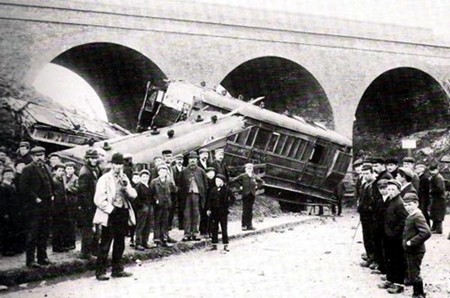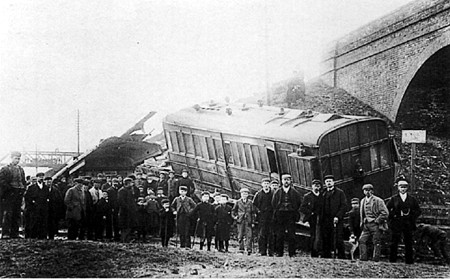|
The Little Bytham rail
crash of 1896

One the biggest rail disasters of
the 19th century was the derailment of a London bound passenger train at
Little Bytham, near Bourne, when the train was wrecked and two passengers
killed while several others were badly injured.
The accident occurred on Saturday 7th March 1896 and involved the Leeds
and Bradford dining car express which left Leeds at 5.30 pm and was due at
King's Cross at 9.20 pm, a journey of ten minutes under four hours. The
train consisted of an engine and a brake van immediately behind the
tender, a Pullman dining car, three ordinary passenger carriages, a
composite carriage comprising first and third compartments, a heavy brake
van carriage and a guard's van bringing up the rear. The train made a
four-minute stop at Grantham before resuming the journey at 7.17 pm with
about 40 passengers aboard but twelve miles down the line, it crashed.
It was running at high speed when three of the last carriages left the
rails. One of them struck the parapet of the bridge which crossed the road
at this point and was completely wrecked, killing two of the passengers
inside. The force of the impact detached the guard's van which also
included three passenger compartments, and was hurled over the bridge to
the road below but miraculously the two lady passengers escaped serious
injury but sustained extensive cuts and bruises and were severely shocked.
Ten passengers in other carriages also sustained minor injuries.
Medical assistance was summoned from Grantham and a special train carrying
four local doctors and a six-man detachment from the station's ambulance
corps was sent to provide medical help equipped with a stretcher and a supply of splints and bandages. Other trains
using the main line were held up and passengers on board with medical
experience volunteered to help at the crash scene where wreckage was
littered along several hundred yards of track.
But conditions for the rescuers were not good, as the Grantham Journal
reported the following week (Saturday 14th March) : "The operations
began in a steady downpour of rain and the night being intensely dark
their work was supremely difficult carried on as it was by the feeble
light of lamps and fires lit at the side of the line."
It later transpired that sections of the line at this point had only
recently been re-laid and the speed of express trains which normally
reached 60 mph and 70 mph along this stretch had been limited to
30 mph but this restriction had been lifted at 4 pm that day and the
flagmen used to provide warnings withdrawn because conditions were then
assumed to be safe.
The Leeds express was reckoned to be one of the fastest on that line,
often clocking 60-70 mph. "While travelling over the newly-laid metals at
terrific speed, and when approaching Little Bytham station, the rear part
of the express left the rails", reported the Grantham Journal. "The
cause of the accident remains to be definitely explained but it is
suggested that the rain which fell during the evening caused the ballast
to settle under the weight of the train and so brought about the
catastrophe. The statement is also vouchsafed that if the speed at which
it was going had not been so great, the whole of the train would have been
wrecked. As it was, the wheels of the derailed carriages travelled for
some distance on the sleepers, and the vehicles were rocked violently from
side to side, causing the greatest alarm to the unfortunate passengers.
"Possibly the train would have been brought
to a standstill without any very serious consequences if the mishap had
occurred at any other spot. But, unfortunately, the train had to cross a
three-arched bridge spanning the highway. Here it was the disaster was
consummated. The composite carriage which was running on the near side of
the line was swung at the parapet with immense force. The impact had
several disastrous results. It levelled the bricks and masonry for a
distance of several yards, and the whole body of the carriage was torn
clean off the wheels and hurled on to the down line.
"The violence of the collision broke also the coupling of the guard's van
which crashed over the parapet of the bridge with the force of a
projectile into the road below. Such was the impact that the solidly-built
carriage was sent halfway up the embankment on the opposite side of the
road, the wheels being deeply embedded in the soil. Two of the passenger
compartments were reduced to a state of utter wreck, the roofing and sides
being wrenched off and smashed out of all resemblance to their former
shape. The latter part of the vehicle bore striking evidence, in shattered
windows and displaced broken woodwork, of the peril through which the
guard and Mrs Paul [one of the passengers] had passed."
An act of bravery by the guard, Ambrose Knott, of King's Cross, London,
helped save Mrs Paul, wife of the Chief Constable of Bradford, who was on
her way to London to visit a sick relative. The newspaper reported: "When
the impact occurred, she was flung into a hedge which partly projected
into the carriage and her terrified appeals for aid were noble responded
to by guard Knott who, himself apparently worse injured than the lady,
nonetheless got out of his van and extricated her from her plight.
Immediately afterwards, she fainted and the brave fellow, summoning all
his strength, took her into his arms, painfully climbed down the
embankment and staggered along with her to the station.
"Fortunately, help was at hand and he was
relieved of his burden. Knott himself then collapsed and he was carried to
the Willoughby Arms Hotel and put to bed. Mrs Paul was also accommodated
at the same hostelry. When medical aid arrived, it was found that Knott
was extremely bruised about the head, and was suffering from shock to the
system. The lady sustained a bad cut on the face and was also much
bruised."
The two passengers who lost their lives were Mrs Ann Mary Bligh, aged 28,
of Pudsey, who was going to visit friends in London, and Mr Michael
Walter, aged 49, a bachelor, of Maida Vale, London, who worked for a
London firm of wholesale clothiers and had been making one of his regular
business trips to Bradford.
An inquest was subsequently held at the Willoughby Arms at Little Bytham
when the jury returned a verdict that they died from injuries accidentally
inflicted in consequence of part of the train in which they were
travelling running off the line, caused by a subsidence of the rail road
which had recently been re-laid. They recommended that in future cases of
re-laying lines, the flagmen are not withdrawn until the road was fully
ballasted.

Return to
Little Bytham

Go to:
Main Index Villages
Index
|

